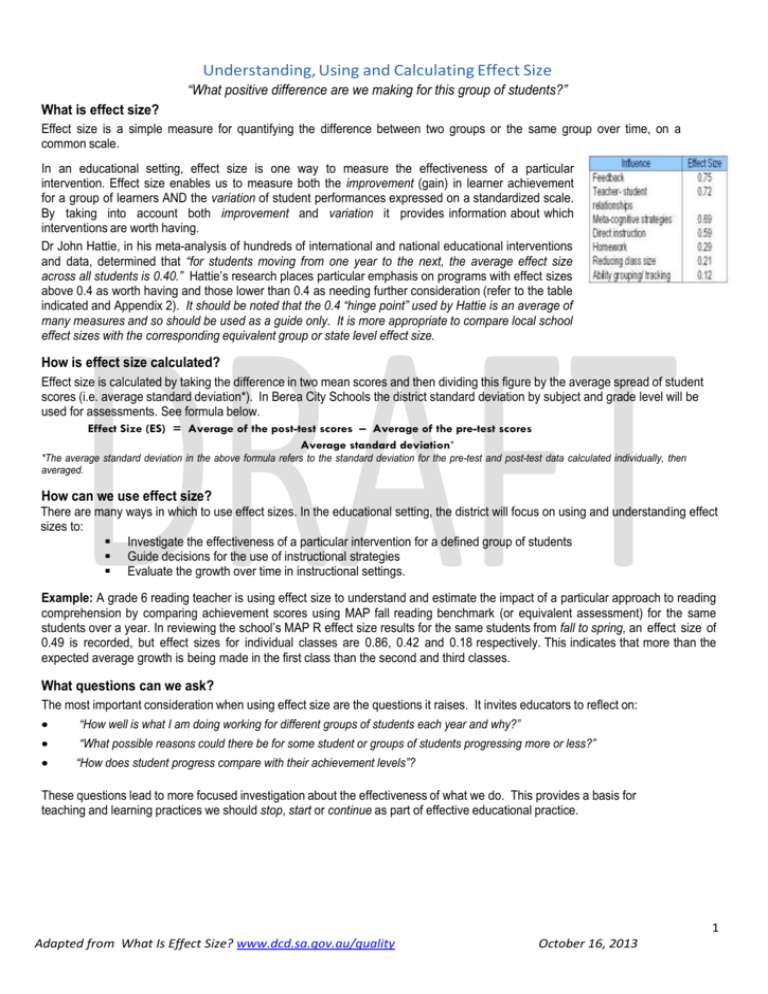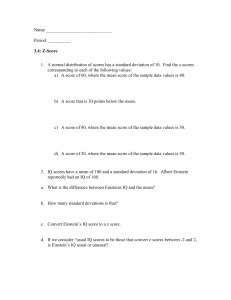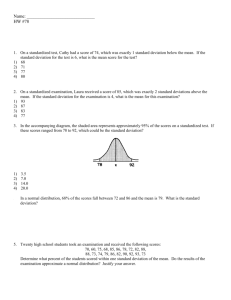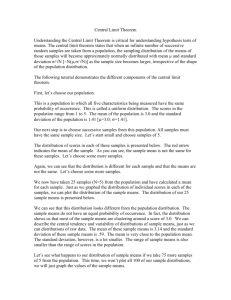BTD/ES Effect Size FAQ - Berea City School District
advertisement

Understanding, Using and Calculating Effect Size “What positive difference are we making for this group of students?” What is effect size? Effect size is a simple measure for quantifying the difference between two groups or the same group over time, on a common scale. In an educational setting, effect size is one way to measure the effectiveness of a particular intervention. Effect size enables us to measure both the improvement (gain) in learner achievement for a group of learners AND the variation of student performances expressed on a standardized scale. By taking into account both improvement and variation it provides information about which interventions are worth having. Dr John Hattie, in his meta-analysis of hundreds of international and national educational interventions and data, determined that “for students moving from one year to the next, the average effect size across all students is 0.40.” Hattie’s research places particular emphasis on programs with effect sizes above 0.4 as worth having and those lower than 0.4 as needing further consideration (refer to the table indicated and Appendix 2). It should be noted that the 0.4 “hinge point” used by Hattie is an average of many measures and so should be used as a guide only. It is more appropriate to compare local school effect sizes with the corresponding equivalent group or state level effect size. How is effect size calculated? Effect size is calculated by taking the difference in two mean scores and then dividing this figure by the average spread of student scores (i.e. average standard deviation*). In Berea City Schools the district standard deviation by subject and grade level will be used for assessments. See formula below. Effect Size (ES) = Average of the post-test scores – Average of the pre-test scores Average standard deviation* *The average standard deviation in the above formula refers to the standard deviation for the pre-test and post-test data calculated individually, then averaged. How can we use effect size? There are many ways in which to use effect sizes. In the educational setting, the district will focus on using and understanding effect sizes to: Investigate the effectiveness of a particular intervention for a defined group of students Guide decisions for the use of instructional strategies Evaluate the growth over time in instructional settings. Example: A grade 6 reading teacher is using effect size to understand and estimate the impact of a particular approach to reading comprehension by comparing achievement scores using MAP fall reading benchmark (or equivalent assessment) for the same students over a year. In reviewing the school’s MAP R effect size results for the same students from fall to spring, an effect size of 0.49 is recorded, but effect sizes for individual classes are 0.86, 0.42 and 0.18 respectively. This indicates that more than the expected average growth is being made in the first class than the second and third classes. What questions can we ask? The most important consideration when using effect size are the questions it raises. It invites educators to reflect on: “How well is what I am doing working for different groups of students each year and why?” “What possible reasons could there be for some student or groups of students progressing more or less?” “How does student progress compare with their achievement levels”? These questions lead to more focused investigation about the effectiveness of what we do. This provides a basis for teaching and learning practices we should stop, start or continue as part of effective educational practice. 1 Adapted from What Is Effect Size? www.dcd.sa.gov.au/quality October 16, 2013 How can effect size be used reliably? Multiple measures are still required Contextual data and triangulation is important. Bernhardt (2004) states that demographic, perception, student learning and process measures about the teaching and learning environment is what provides a comprehensive picture of what makes a difference to learners Caution for all small sample size Hattie suggests that care should be taken in the interpretation of any findings for small sample sizes as outliers in student scores can skew the effect sizes and may require special consideration. - What possible reasons could there be for why that group of students recorded these estimated effect sizes? What will we do for students who are achieving at expected achievement levels but not the expected growth effect size. Are there additional data points that serve as evidence of growth? Accuracy is enhanced when comparing the exact same group of students When comparing pre-test and post-test scores, it is most useful to ensure that all students are tested and that scores from exactly the same group of students are compared. Student roster verification will be an important. In summary, it is important to base the interpretation of effect size on the full range of contextual and measurement factors. Standard Deviation (SD) SD is a measure of the spread of all individual student scores relative to the mean score. When comparing the SD for schools with the same mean score, a larger SD indicates a larger spread of scores (i.e. more lower and higher scores). Is the effect size a real and accurate result? To determine whether the effect size is a real result, a confidence interval may be used to describe the level of uncertainty (or error) of inferring the true value, but this calculation is not within scope of this paper. There are also measurement errors that can occur when assessments are not properly designed or due to differences in test administration. Effect size calculations are recommended for assessments that have high levels of validity and reliability (e.g. validated and research based standardized/norm-referenced assessments). These factors are a reminder that in any statistical model there are pros and cons. The district will continue to review the growth calculator options in 2013-2014 based on the pilot year. Appendix 2: Table of Effect sizes of Influences The following table (Hattie, 2012) provides information about the large range of strategies and programs of learning and their influence on student achievement as measured by effect size. The research indicates that the majority of interventions and strategies have an influence or level of workability. It is recommended that this information be used by educators to further discuss, evaluate and question what might be able to be changed (i.e. low influences) or strengthened (i.e. high influences) as part of educational practice. References: Bernhardt, V., (2004). Data Analysis for Continuous School Improvement. Eye on Education, Larchmont: NY. Coe, R., (2002). It’s the Effect Size, Stupid. What effect size is and why it is important presentation to the Annual Conference of the British Educational Research Association, England 2002. Retrieved November 2011 from http://www.leeds.ac.uk/educol/documents/00002182.htm Earl, L. & Katz, S., (2006). Leading schools in a Data-Rich World: Harnessing data for school improvement. Corwin Press, California. Hattie, J., (2012). Visible Learning for Teachers, Maximising Impact on Learning. Routledge, Oxford: UK. Hattie, J., & Masters, D., (2011). Visible Learning Plus. Supporting Material Visible Learning Workshop presentation in Adelaide, South Australia, 2011. Hattie, J., (2003). "Teachers Make a Difference, What is the research evidence?". 2003 - Building Teacher Quality: What does the research tell us? Retrieved November 2011 from http://research.acer.edu.au/research_conference_2003/4 Schagen, I., & Hodgen, E., (2009). How Much Difference Does it make? Notes on Understanding, Using, and Calculating Effect Size for Schools. Retrieved from http://www.educationcounts.govt.nz/publications/schooling/36097/36098 2 Adapted from What Is Effect Size? www.dcd.sa.gov.au/quality October 16, 2013 Appendix 1: Effect size calculation example The following represents the 6 step process for calculating effect size manually and the corresponding formulas that can be used in MS Excel (indicated in shaded blue text) to calculate these statistical measures. The attached figure below contains individual student data for a typical assessment. 1. Mean score (or average) is calculated by adding all the individual student scores together and then dividing by the total number of student scores. In the example provided (see attached Figure): Mean score (for 2010) = (551+502+443+ …+380+322) ÷ 28 = =AVERAGE(B3:B30) = 443.5 [See Excel Figure, cell B31] Mean score (for 2011) = (535+495+448+ …+505+448) ÷ 28 = =AVERAGE(C3:C30) = 502.3 [See Excel Figure, cell C31] 2. the difference between two mean scores (also referred to as the ‘gain’ score in ACARA NAPLAN resources) =C31–B31 = 502.3 – 443.5 = 58.7 [See Excel Figure, cell D32] 3. Standard Deviation (SD- At BCSD the district standard deviation will be used for greater reliability/validity) can be a complicated formula to calculate manually (i.e. basically the average of the sum of the squared differences from the mean score) and can be easily calculated in MS Excel as follows: Standard Deviation (for 2010): =STDEV(B3:B30) = 65.7 [See Excel Figure, cell B33] Standard Deviation (for 2011): =STDEV(C3:C30) = 62.2 [See Excel Figure, cell C33] 4. Average spread is the average of the two standard deviations in step 3 above: =AVERAGE(B33:C33) = 64.0 [See Excel Figure, cell D34] 5. Overall Effect size is equal to the difference between the two mean scores (post-test and pre-test) divided by the average Standard Deviation. Therefore we need to divide the result in step 2) by the result in step 4) above: =D32/D34 = 58.7 ÷ 64.0 = 0.92 [See Excel Figure, cell E35] 6. Individual student effect size is equal to the difference between the individual student post-test and pre-test score divided by the average Standard Deviation for the class: =D3/D34 (for student 17) = -16 ÷ 64.0 = -0.25 [See Excel Figure, cell E3] … D30/D34 (for student 13) = 126 ÷ 64.0 = 1.97 [See Excel Figure, cell E30] *For assessments that measure change over 2 years, it is necessary to divide the effect size figure by 2 to approximate yearly growth, particularly when comparisons are made with other yearly based effect size figures (e.g. Appendix 2). **All cell locations in Excel have a referencing system that are needed for calculating formulas. For example, Student Id:17 scored 551 in 2010 & in 2011 scored 535. The cell location e.g. cell ‘B3’ refers to row3 and column B. locate ‘B3’ (i.e. row 3 & column B), the value is ‘551’. Standard Deviation (SD) SD is a measure of the spread of all individual student scores relative to the mean score. When comparing the SD for schools with the same mean score, a larger SD indicates a larger spread of scores (i.e. more lower and higher scores). 3 Adapted from What Is Effect Size? www.dcd.sa.gov.au/quality October 16, 2013








